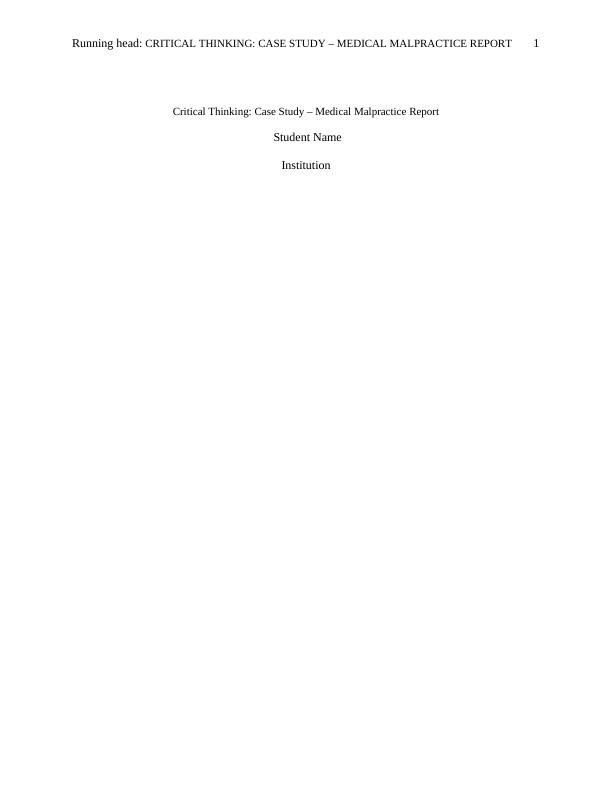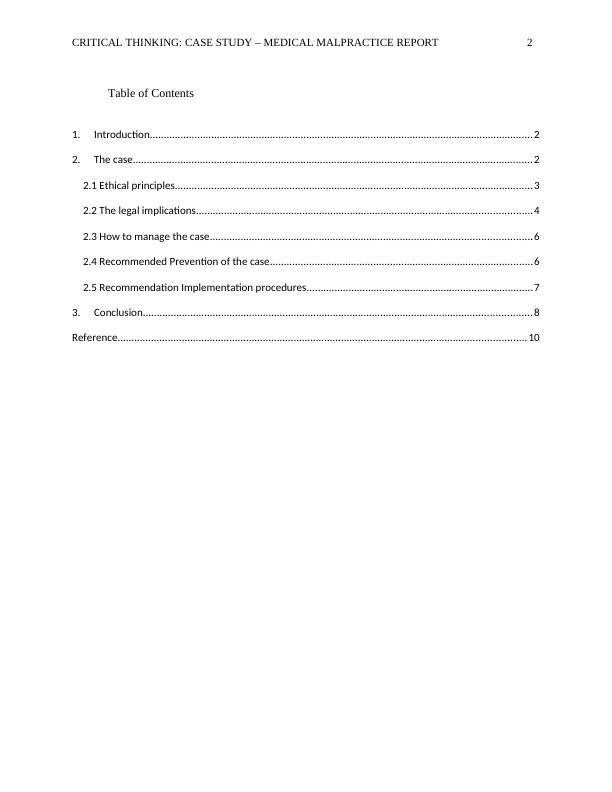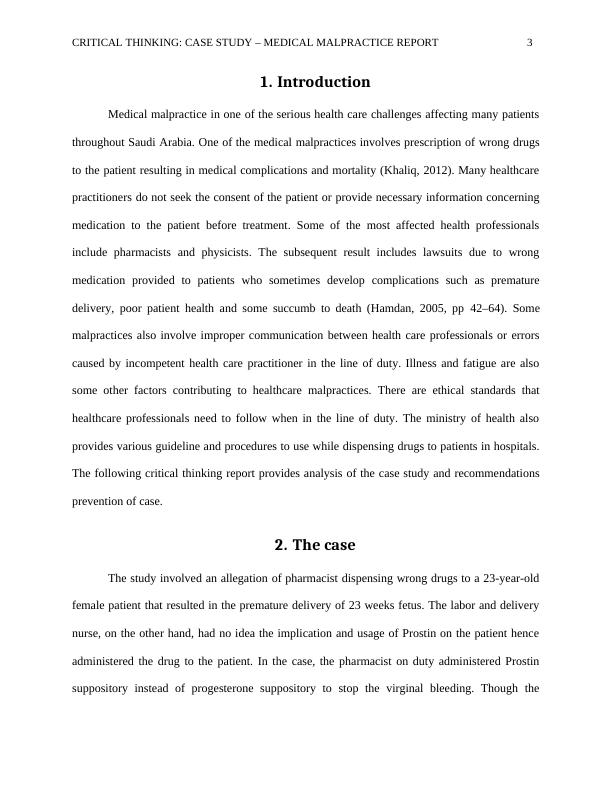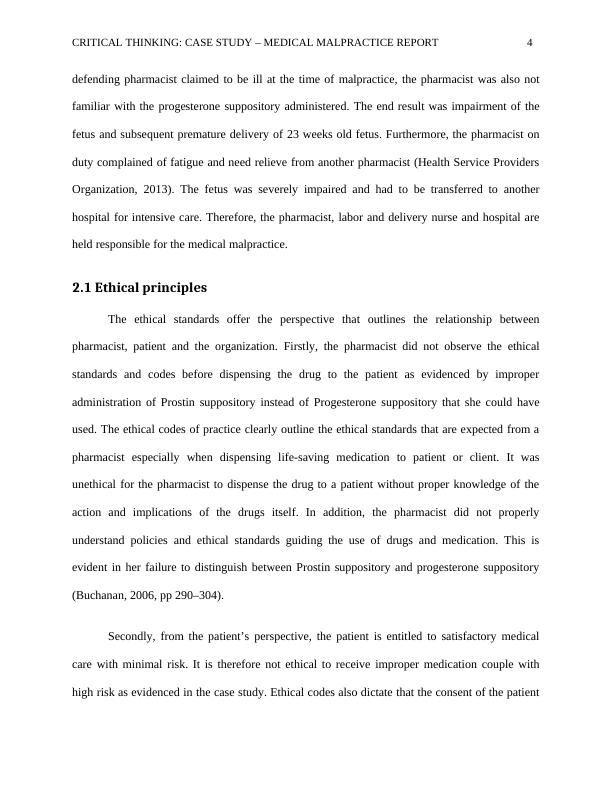Case Study – Medical Malpractice Report
Added on 2021-04-21
11 Pages2682 Words207 Views
Running head: CRITICAL THINKING: CASE STUDY – MEDICAL MALPRACTICE REPORT1Critical Thinking: Case Study – Medical Malpractice ReportStudent NameInstitution

CRITICAL THINKING: CASE STUDY – MEDICAL MALPRACTICE REPORT 2Table of Contents1.Introduction.........................................................................................................................................22.The case...............................................................................................................................................22.1 Ethical principles................................................................................................................................32.2 The legal implications........................................................................................................................42.3 How to manage the case...................................................................................................................62.4 Recommended Prevention of the case..............................................................................................62.5 Recommendation Implementation procedures.................................................................................73.Conclusion...........................................................................................................................................8Reference..................................................................................................................................................10

CRITICAL THINKING: CASE STUDY – MEDICAL MALPRACTICE REPORT 31.IntroductionMedical malpractice in one of the serious health care challenges affecting many patientsthroughout Saudi Arabia. One of the medical malpractices involves prescription of wrong drugsto the patient resulting in medical complications and mortality (Khaliq, 2012). Many healthcarepractitioners do not seek the consent of the patient or provide necessary information concerningmedication to the patient before treatment. Some of the most affected health professionalsinclude pharmacists and physicists. The subsequent result includes lawsuits due to wrongmedication provided to patients who sometimes develop complications such as prematuredelivery, poor patient health and some succumb to death (Hamdan, 2005, pp 42–64). Somemalpractices also involve improper communication between health care professionals or errorscaused by incompetent health care practitioner in the line of duty. Illness and fatigue are alsosome other factors contributing to healthcare malpractices. There are ethical standards thathealthcare professionals need to follow when in the line of duty. The ministry of health alsoprovides various guideline and procedures to use while dispensing drugs to patients in hospitals.The following critical thinking report provides analysis of the case study and recommendationsprevention of case.2.The caseThe study involved an allegation of pharmacist dispensing wrong drugs to a 23-year-oldfemale patient that resulted in the premature delivery of 23 weeks fetus. The labor and deliverynurse, on the other hand, had no idea the implication and usage of Prostin on the patient henceadministered the drug to the patient. In the case, the pharmacist on duty administered Prostinsuppository instead of progesterone suppository to stop the virginal bleeding. Though the

CRITICAL THINKING: CASE STUDY – MEDICAL MALPRACTICE REPORT 4defending pharmacist claimed to be ill at the time of malpractice, the pharmacist was also notfamiliar with the progesterone suppository administered. The end result was impairment of thefetus and subsequent premature delivery of 23 weeks old fetus. Furthermore, the pharmacist onduty complained of fatigue and need relieve from another pharmacist (Health Service ProvidersOrganization, 2013). The fetus was severely impaired and had to be transferred to anotherhospital for intensive care. Therefore, the pharmacist, labor and delivery nurse and hospital areheld responsible for the medical malpractice. 2.1 Ethical principlesThe ethical standards offer the perspective that outlines the relationship betweenpharmacist, patient and the organization. Firstly, the pharmacist did not observe the ethicalstandards and codes before dispensing the drug to the patient as evidenced by improperadministration of Prostin suppository instead of Progesterone suppository that she could haveused. The ethical codes of practice clearly outline the ethical standards that are expected from apharmacist especially when dispensing life-saving medication to patient or client. It wasunethical for the pharmacist to dispense the drug to a patient without proper knowledge of theaction and implications of the drugs itself. In addition, the pharmacist did not properlyunderstand policies and ethical standards guiding the use of drugs and medication. This isevident in her failure to distinguish between Prostin suppository and progesterone suppository(Buchanan, 2006, pp 290–304). Secondly, from the patient’s perspective, the patient is entitled to satisfactory medicalcare with minimal risk. It is therefore not ethical to receive improper medication couple withhigh risk as evidenced in the case study. Ethical codes also dictate that the consent of the patient

End of preview
Want to access all the pages? Upload your documents or become a member.
Related Documents
Case Study Analysislg...
|9
|2079
|406
Medication Error as Safety Indicator of Healthlg...
|15
|4391
|144
Legal and Professional Issues in Nursinglg...
|11
|824
|80
Human Factors Analysis Classification System in Health Sectorlg...
|6
|1993
|303
Challenges to Healthcare in Indialg...
|6
|1575
|13
Assignment Medication Errorslg...
|18
|4875
|83